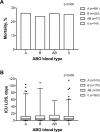ABO blood types and major outcomes in patients with acute hypoxaemic respiratory failure: A multicenter retrospective cohort study
- PMID: 30359446
- PMCID: PMC6201964
- DOI: 10.1371/journal.pone.0206403
ABO blood types and major outcomes in patients with acute hypoxaemic respiratory failure: A multicenter retrospective cohort study
Abstract
Introduction: ABO blood type A was reported to correlate with an increased risk of acute respiratory distress syndrome (ARDS) in white patients with severe sepsis and major trauma compared with patients with other blood types. Information regarding ABO phenotypes and major outcomes in patients with ARDS is unavailable. The primary aim was to determine the relationship between ABO blood type A and intensive care unit (ICU) mortality in patients with acute hypoxemic respiratory failure (AHRF). The secondary aim was to describe the association between ABO blood type A and ICU length of stay (LOS) in this study population.
Methods: In a multicenter, retrospective cohort study, we collected the clinical records of patients admitted from January 2012 to December 2014 in five ICUs of Northern Italy. We included adult white patients admitted to the ICU who were diagnosed with AHRF requiring mechanical ventilation.
Results: The electronic records of 1732 patients with AHRF were reviewed. The proportion of patients with ABO blood type A versus other blood types was 39.9% versus 60.1%. ICU mortality (25%) and ICU LOS (median [interquartile range], 5 [2-12] days) were not different when stratified by ABO blood type (ICU mortality, overall p value = 0.905; ICU LOS, overall p value = 0.609). SAPSII was a positive predictor of ICU mortality (odds ration [OR], 32.80; 95% confidence interval [CI], 18.80-57.24; p < 0.001) and ICU LOS (β coefficient, 0.55; 95% CI, 0.35-0.75; p < 0.001) at multivariate analyses, whereas ABO blood type did not predict ICU outcome when forced into the model.
Conclusion: ABO blood type did not correlate with ICU mortality and ICU LOS in adult patients with AHRF who were mechanically ventilated.
Conflict of interest statement
The authors have declared that no competing interests exist.
Figures
References
-
- Bellani G, Laffey JG, Pham T, Fan E, Brochard L, Esteban A, et al.; LUNG SAFE Investigators; ESICM Trials Group. Epidemiology, Patterns of Care, and Mortality for Patients With Acute Respiratory Distress Syndrome in Intensive Care Units in 50 Countries. JAMA 2016; 315:788–800. - PubMed
-
- Rezoagli E, Fumagalli R, Bellani G. Definition and epidemiology of acute respiratory distress syndrome. Ann Transl Med 2017; 5:282 doi: 10.21037/atm.2017.06.62 - DOI - PMC - PubMed
-
- Calfee CS, Eisner MD, Parsons PE, Thompson BT, Conner ER Jr, Matthay MA, et al.; NHLBI Acute Respiratory Distress Syndrome Clinical Trials Network. Soluble intercellular adhesion molecule-1 and clinical outcomes in patients with acute lung injury. Intensive Care Med 2009; 35:248–57. 10.1007/s00134-008-1235-0 - DOI - PMC - PubMed


